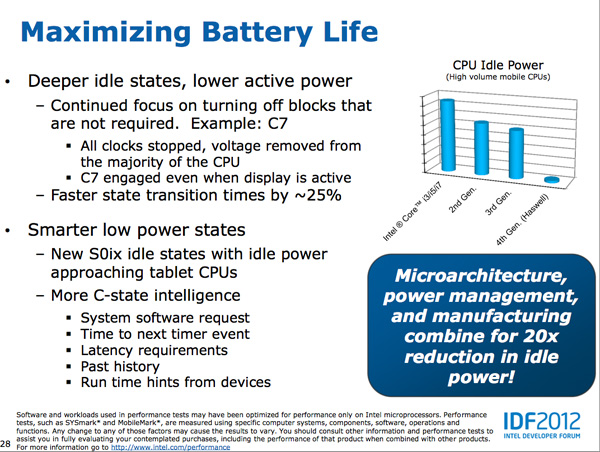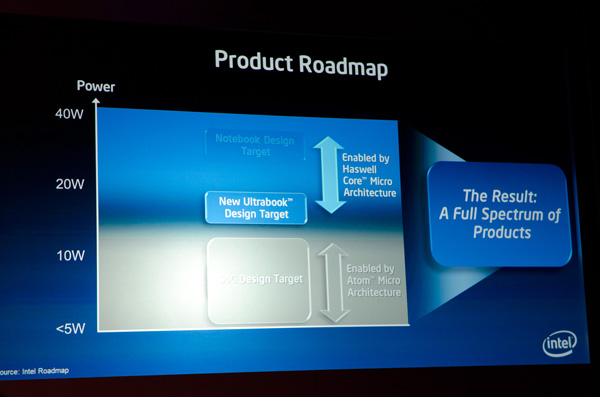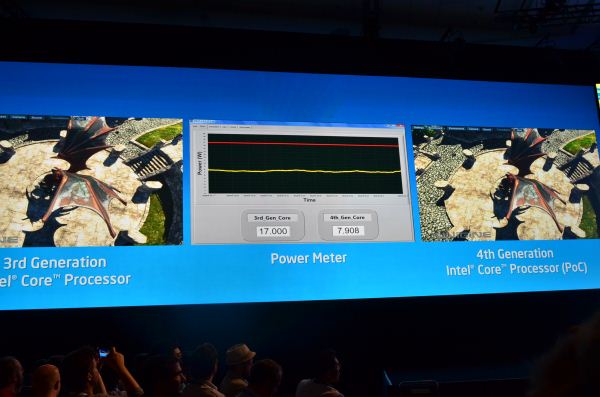Intel's Haswell Architecture Analyzed: Building a New PC and a New Intel
by Anand Lal Shimpi on October 5, 2012 2:45 AM ESTOther Power Savings
Haswell's power savings come from three sources, all of which are equally important. We already went over the most unique: Intel's focus on reducing total platform power consumption by paying attention to everything else on the motherboard (third party controllers, voltage regulation, etc...). The other two sources of power savings are more traditional, but still very significant.

At the micro-architecture level Intel added more power gating and low power modes to Haswell. The additional power gating gives the power control unit (PCU) more fine grained control over shutting off parts of the core that aren't used. Intel published a relatively meaningless graph showing idle power for standard voltage mobile Haswell compared to the previous three generations of Core processors.
Haswell can also transition between power states approximately 25% faster than Ivy Bridge, which lets the PCU be a bit more aggressive in which power state it selects since the penalty of coming out of it is appreciably lower. It's important to put the timing of all of this in perspective. Putting the CPU cores to sleep and removing voltage/power from them even for a matter of milliseconds adds up to the sort of savings necessary to really enable the sort of always-on, always-connected behavior Haswell based systems are expected to deliver.
Intel has also done a lot of work at the process level to bring Haswell's power consumption down. As a tock, Haswell is the second micro-architecture to use Intel's new 22nm tri-gate transistors. The learnings from Ivy Bridge are thus all poured into Haswell. Intel wasn't too specific on what it did on the manufacturing side to help drive power down in Haswell other than to say that a non-insignificant amount of work came from the fabs.
The Fourth Haswell
At Computex Intel's Mooly Eden showed off this slide that positioned Haswell as a 15-20W part, while Atom based SoCs would scale up to 10W and perhaps beyond:
Just before this year's IDF Intel claimed that Haswell ULT would start at 10W, down from 17W in Sandy/Ivy Bridge. Finally, at IDF Intel showed a demo of Haswell running the Unigen Heaven benchmark at under 8W:
The chain of events tells us two things: 1) Intel likes to play its cards close to its chest, and 2) the sub-10W space won't be serviced by Atom exclusively.
Intel said Haswell can scale below 10W, but it didn't provide a lower bound. It's too much to assume Haswell would go into a phone, but once you get to the 8W point and look south you open yourself up to fitting into things the size of a third generation iPad. Move to 14nm, 10nm and beyond then it becomes more feasible that you could fit this class of architecture into something even more portable.
Intel is being very tight lipped about the fourth client Haswell (remember the first three were desktop, mobile and ultra-low-volt/Ultrabook) but it's clear that it has real aspirations to use it in a space traditionally reserved for ARM or Atom SoCs.
One of the first things I ever heard about Haswell was that it was Intel's solution to the ARM problem. I don't believe a 10W notebook is going to do anything to the ARM problem, but a sub-8W Haswell in an iPad 3 form factor could be very compelling. Haswell won't be fanless, but Broadwell (14nm) could be. And that could be a real solution to the ARM problem, at least outside of a phone.
As I said before, I don't see Haswell making it into a phone but that's not to say a future derivative on a lower power process wouldn't.













245 Comments
View All Comments
Peanutsrevenge - Friday, October 5, 2012 - link
What the hell are you guys bitching about?Of course the iPhone articles are going to be longer and more numerous than GS3 articles.
iPhone releases come with new iOS releases and have their own eco-system.
Android phone releases use a common OS across them and therefore much of what's in one article doesn't need repeating in another.
Anand liking Apple is not our problem, I can see why people like them (not so much Anand) and that's fine, personally I dislike them (hate was originally typed, but was edited due to being incorrect), but still respect them and respect people who purchase their products (and pay for their litigation).
An entire page of comments talking about how Anand isn't allowed to like or talk about Apple products because you guys don't like is ridiculous, they're a PC company and should exist on a PC website.
Grow up.
Kepe - Friday, October 5, 2012 - link
Sure, but I'm talking about dedicating entire, long articles to such things as the iPhone display or why it doesn't have a certain feature and so on. The SGS III has a very interesting display, too. Still it didn't get nearly as much attention. Of course Anand is allowed to talk about Apple products. What I want, though, is Anand(tech) to be as thorough in reviewing other products, too, or then stop making those huge articles only about Apple products. Because that is biased.In the Macbook Pro Retina article Anand talked about the cooling system and the fan blades for one page. When I read any other laptop review on Anandtech, cooling is briefly described in a sentence or two.
Dedicating so much attention to just one company's products makes it look like Anandtech is biased. And that is not good.
Magik_Breezy - Sunday, October 14, 2012 - link
Hopefully because of these comments they'll finally see what we want, not some Apple crap. Good engineering stupid managementSpunjji - Thursday, October 18, 2012 - link
Nailed it.vFunct - Saturday, October 6, 2012 - link
Android products would get more coverage if they bothered to do any engineering on them. Since they don't push the technology the way Apple does, they don't need a more in-depth review.StevoLincolnite - Saturday, October 6, 2012 - link
You're kidding right? Hardware wise Apple has always been behind the curve compared to the competition in every facet of it's product line-ups or very quickly beaten.lmcd - Saturday, October 6, 2012 - link
Umm, I would disagree there. Apple has always been ahead of the curve in GPUs and this is the FIRST TIME SINCE BEFORE THE A-SERIES that Apple has had a GPU without an overwhelming lead on the competition for more than half a year.*While GPU selection isn't always huge, it's one of the biggest points of differentiation in mobile chips, along with power use.
*excluding the A4 if you count from when it was first in a phone as opposed to in a tablet.
Magik_Breezy - Sunday, October 14, 2012 - link
The last time I played a game on my phone was about 8 months ago and I'm 15! To say that Apple pushes their hardware is naive as it gets.The Galaxy S III was the best purchase Ive made, even my mum doesn't like my iPhone 4.
vFunct - Sunday, October 7, 2012 - link
Yes, Apple products are always ahead of compromised Android products.Android devices are badly engineered, like incorporating LTE when the battery can't handle it, for example. Apple doesn't compromise on their design.
Kepe - Monday, October 8, 2012 - link
How much does Apple pay you for a comment praising them?